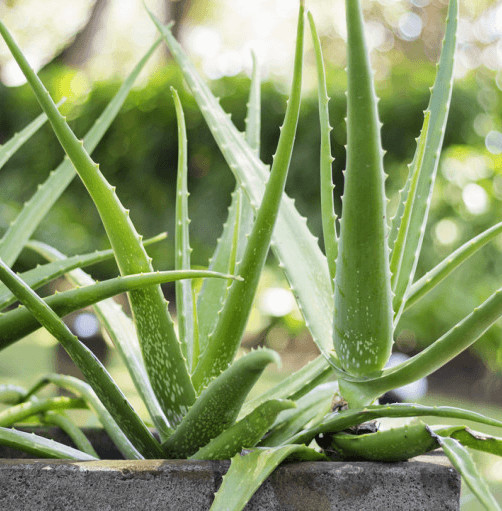- +033 2572 7171
- info@dhanvantary.com

4.5 Rating | 4500 Review

4.5 Rating | 4500 Review
Ghritkumari is a famous herb used in Ayurveda since long time ago. It is known with the scientific name, Aloe barbadensis. It belongs to the family liliaceae. It is perennial, xerophytic, shrubby and pea green color plant. These stems are stout and thick. It grows up to 80 to 100 cm in length. The root system is of fibrous type. The plant has thick, lanceolate, fleshy leaves having sharp points. These leaves can grow up to 18 inches long and 2 inches wide. These are of green to grey green colorVarious Active Phytochemicals are as following:

There are about 12 anthraquinones. Aloin and emodine are from those 12 anthraquinones. These compounds enriched with anti-bacterial, anti-viral and analgesic properties.
It contains 20 amino acids which are required by humans and 7 to 8 essential amino acids. These amino acids known to provide anti-bacterial and anti-inflammatory effects.
Ghritkumari consists of monosacchrides and polysaccharides.
Hormones of Ghritkumari play vital role to treat various diseases. Some of the hormones are gibberellins and auxins. These have healing and anti-inflammatory properties.
Ghritkumari contains vitamins like A, C and E, folic acid, choline and B12. These nourish blood, body cells and to neutralize free radicals.
Kumari provides four kinds of steroids. These are campesterol, lupeol, cholesterol and B sisosterol. These steroids have properties like analgesic, anti-inflammatory and antiseptic.
These consists various minerals such as copper, selenium, magnesium, sodium and more. These are important in the various enzyme systems. These systems perform various metabolic functions and some of these act as antioxidants.
It consists of various enzymes like catalase, alkaline phosphatase, amylase, bradykinase cyclooxidase, cylooxygenase, lipase, oxidase, carboxypeptidase, carboxylase and superoxidase dismutase. These are essential in catabolism of fats and carbohydrates. One of the enzyme bradykinase helps to reduce severe inflammation when applied on the skin.
Kingdom
Plantae
Subkingdom
Tracheobionta
Superdivision
Spermatophyta
Division
Magnoliophyta
Class
Liliopsida
Subclass
Liliidae
Order
Liliales
Family
Aloeaceae
Genus
Aloe
Species
Barbadensis
Ghritkumari is native to the Mediterranean region of North Africa, Canary Islands and Southern Europe. It is cultivated in USA, Mexico, Asia, southern Europe, Aruba, Bonaire, Bermuda, West Indies, the Bahamas, Central and South America. It spreads as wild in the coasts and coastal regions of south India. It also grows in parts of these cities, Maharashtra, Madhya Pradesh, Chhattisgarh and Gujarat.
|
Hindi / Sanskrit |
English |
||
|
Rasa |
Tikta |
Taste |
Bitter |
|
Guna |
Guru, Snigdha, Pichhila |
Physical Property |
Heavy, Unctuous, Sticky |
|
Virya |
Sheeta |
Potency |
Cold |
|
Vipaka |
Katu |
Metabolic Property (After Digestion) |
Pungent |
It helps to balances all three doshas.
The leaves are evenly long and of triangular shape. The leaves of the plant consists of three layers, inner layer has 99% water and other 1% is filled with biochemical. Middle layer is formed of latex, have yellow color sap in it. Last is the outer layer, a thick layer made of 15 to 20 cells, protects the whole plant. The leaves of the plants are rich in water so it can survive for years and years. The leaves has spiky type margins. Flowers of the kumari is cylindrical, pendulous and of dense racemes. These are of yellow color and long up to 2 to 3 cm. the roots of the plants are thick and fibrous. The plant fruits are of triangular shape and containing plenty of seeds in it.
Leaves
Avoid use in pregnancy and breast feeding.
Oral intake of aloe can cause abdominal cramps and diarrhea sometimes.
